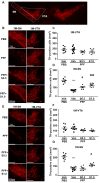T-Type Ca2+ Enhancer SAK3 Activates CaMKII and Proteasome Activities in Lewy Body Dementia Mice Model
- PMID: 34201181
- PMCID: PMC8228122
- DOI: 10.3390/ijms22126185
T-Type Ca2+ Enhancer SAK3 Activates CaMKII and Proteasome Activities in Lewy Body Dementia Mice Model
Abstract
Lewy bodies are pathological characteristics of Lewy body dementia (LBD) and are composed of α-synuclein (α-Syn), which is mostly degraded via the ubiquitin-proteasome system. More importantly, 26S proteasomal activity decreases in the brain of LBD patients. We recently introduced a T-type calcium channel enhancer SAK3 (ethyl-8-methyl-2,4-dioxo-2-(piperidin-1-yl)- 2H-spiro[cyclopentane-1,3-imidazo [1,2-a]pyridin]-2-ene-3-carboxylate) for Alzheimer's disease therapeutics. SAK3 enhanced the proteasome activity via CaMKII activation in amyloid precursor protein knock-in mice, promoting the degradation of amyloid-β plaques to improve cognition. At this point, we addressed whether SAK3 promotes the degradation of misfolded α-Syn and the aggregates in α-Syn preformed fibril (PFF)-injected mice. The mice were injected with α-Syn PFF in the dorsal striatum, and SAK3 (0.5 or 1.0 mg/kg) was administered orally for three months, either immediately or during the last month after injection. SAK3 significantly inhibited the accumulation of fibrilized phosphorylated-α-Syn in the substantia nigra. Accordingly, SAK3 significantly recovered mesencephalic dopamine neurons from cell death. Decreased α-Syn accumulation was closely associated with increased proteasome activity. Elevated CaMKII/Rpt-6 signaling possibly mediates the enhanced proteasome activity after SAK3 administration in the cortex and hippocampus. CaMKII/Rpt-6 activation also accounted for improved memory and cognition in α-Syn PFF-injected mice. These findings indicate that CaMKII/Rpt-6-dependent proteasomal activation by SAK3 recovers from α-Syn pathology in LBD.
Keywords: Alzheimer’s disease; Lewy body dementia; SAK3; T-type Ca2+ channel enhancer; alpha-synuclein; amyloid β plaque; proteasome activity.
Conflict of interest statement
The authors declare no conflict of interest.
Figures









Similar articles
-
SAK3 Administration Improves Spine Abnormalities and Cognitive Deficits in AppNL-G-F/NL-G-F Knock-in Mice by Increasing Proteasome Activity through CaMKII/Rpt6 Signaling.Int J Mol Sci. 2020 May 28;21(11):3833. doi: 10.3390/ijms21113833. Int J Mol Sci. 2020. PMID: 32481611 Free PMC article.
-
Single Administration of the T-Type Calcium Channel Enhancer SAK3 Reduces Oxidative Stress and Improves Cognition in Olfactory Bulbectomized Mice.Int J Mol Sci. 2021 Jan 13;22(2):741. doi: 10.3390/ijms22020741. Int J Mol Sci. 2021. PMID: 33451040 Free PMC article.
-
T-type calcium channel enhancer SAK3 promotes dopamine and serotonin releases in the hippocampus in naive and amyloid precursor protein knock-in mice.PLoS One. 2018 Dec 20;13(12):e0206986. doi: 10.1371/journal.pone.0206986. eCollection 2018. PLoS One. 2018. PMID: 30571684 Free PMC article.
-
Alzheimer's disease therapeutic candidate SAK3 is an enhancer of T-type calcium channels.J Pharmacol Sci. 2019 Feb;139(2):51-58. doi: 10.1016/j.jphs.2018.11.014. Epub 2018 Dec 18. J Pharmacol Sci. 2019. PMID: 30600144 Review.
-
[Role of T-type Calcium Channels in Regulating Neuronal Function].Yakugaku Zasshi. 2020;140(10):1207-1212. doi: 10.1248/yakushi.20-00138. Yakugaku Zasshi. 2020. PMID: 32999199 Review. Japanese.
Cited by
-
Pathogenic Impact of α-Synuclein Phosphorylation and Its Kinases in α-Synucleinopathies.Int J Mol Sci. 2022 Jun 1;23(11):6216. doi: 10.3390/ijms23116216. Int J Mol Sci. 2022. PMID: 35682892 Free PMC article. Review.
-
α-Synuclein decoy peptide protects mice against α-synuclein-induced memory loss.CNS Neurosci Ther. 2023 Jun;29(6):1547-1560. doi: 10.1111/cns.14120. Epub 2023 Feb 14. CNS Neurosci Ther. 2023. PMID: 36786129 Free PMC article.
-
Protein Kinases and Neurodegenerative Diseases.Int J Mol Sci. 2023 Mar 14;24(6):5574. doi: 10.3390/ijms24065574. Int J Mol Sci. 2023. PMID: 36982647 Free PMC article.
-
Translocation of TMEM175 Lysosomal Potassium Channel to the Plasma Membrane by Dynasore Compounds.Int J Mol Sci. 2021 Sep 29;22(19):10515. doi: 10.3390/ijms221910515. Int J Mol Sci. 2021. PMID: 34638858 Free PMC article.
References
MeSH terms
Substances
LinkOut - more resources
Full Text Sources
Medical
Miscellaneous

